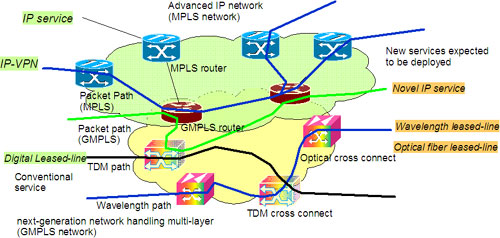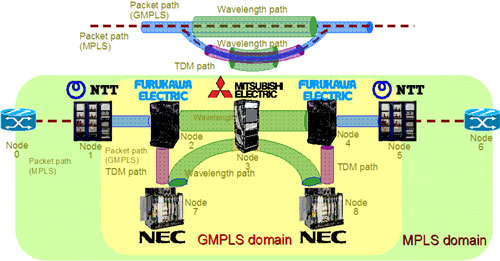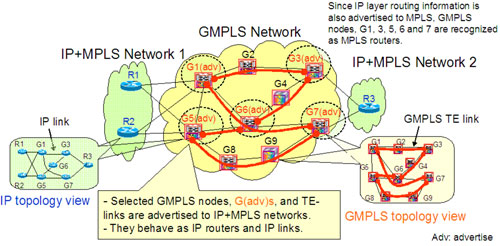Nippon Telegraph and Telephone
Corporation (NTT; Head Office: Chiyoda-ku, Tokyo; President:
Norio Wada), NEC Corporation (Office: Minato-ku Tokyo;
President: Akinobu Kanasugi), The Furukawa Electric Co.,
Ltd. (Office: Chiyoda-ku; President: Kouji Ishihara), and
Mitsubishi Electric Corporation (President & CEO: Tamotsu
Nomakuchi) will conduct the world's first successful demonstration
of interworking between legacy MPLS (Multi-Protocol Label
switching) for IP network control and GMPLS (Generalized
MPLS) for next-generation photonic network control. This
interworking will produce a broadband and economical IP
network environment. This interworking technology will
realize the smooth introduction of the next generation
high-speed and flexible backbone network without demanding
that changes be made to existing IP and MPLS network configurations.
Moreover, the novel high-speed and flexible network services
offered by GMPLS technology can now be provided in addition
to existing IP and MPLS services.
This interworking experiment will be demonstrated from
October 26 and to 28, 2003 at the international conference
MPLS2003 exhibition booth, in Washington D.C. USA. In MPLS2003,
world telecommunication carriers and venders will debate
the novel de-facto MPLS technology, which is an advanced
IP network control technology used to provide IP VPN services.
- Background
Due to the explosive increase in the number of Internet
users and various new services, traffic volume is doubling
every year. This trend will continue since novel network
applications like VoIP and Video on Demand are emerging.
These types of services are difficult to realize on the
existing best effort type IP network. Accordingly, enterprise
users, which employ various network applications, utilize
more dedicated network services like IP-VPN (*4) and Ethernet
as well as the leased-line service. This suggests the need
for an adaptive network control mechanism that offers various
transmission speeds and levels of communication quality
to support user demands and new applications in the next
generation network.
MPLS and GMPLS technologies are the key contenders to achieve
this adaptive network control mechanism (refer to Fig.
1). MPLS realizes traffic control in the IP network. Using
the circuit switching concept seen in the telephone network,
it establishes and handles traffic flows that satisfy different
service quality demands. At present, MPLS technology is
being used to realize traffic management in Internet service
providers and to realize IP-VPN services.
GMPLS is a new control technology designed for the next-generation
photonic network. GMPLS is an extension of the MPLS concept
to the circuit switching network and the optical fiber
network. GMPLS enables unified control management of the
network layers (packet / TDM / wavelength / optical fiber).
The use of GMPLS unifies network operations which will
yield significant network operation cost reductions. Moreover,
GMPLS offers the novel network service of optical wavelength
leased-line service in which users can freely change destination
and quality.
In order to introduce the next-generation network smoothly,
MPLS and GMPLS must cooperate without alteration of the
existing IP network equipment.

Fig .1 Schematic of next-generation network and services
over various paths
- Technical points
PIL has succeeded in seamlessly connecting an MPLS
network and a GMPLS network by using GMPLS routing
and signaling
technology.
The trial network setup is shown in Figure 2. The GMPLS
domain consists of a photonic MPLS router (*5) (IP/wavelength)
of NTT, a digital cross connect (TDM/wavelength) of NEC,
a GMPLS supported MPLS router (IP/TDM/wavelength) of
Furukawa Electric, and optical cross connect (wavelength/fiber)
of Mitsubishi Electric. Only the control parts of these
components were examined. Control software that can handle
at least two layers was developed and implemented by
each
company. The above expressions within the brackets represent
the function and the layer handled by each company’s equipment.
All equipment can run a GMPLS-compliant routing protocol
(GMPLS OSPF-TE). Each active component advertises the
function and the layer that it handles. This allows
all GMPLS equipment
to recognize the layers handled by other equipment.
Since a wide variety of network equipment (e.g. IP router
and a cross connect) will coexist in a GMPLS network,
it is essential to verify the interoperability between
multi-vendor
network equipment. The four companies have already established
a multi-layer GMPLS signaling technology using the GMPLS
signaling protocol (GMPLS RSVP-TE). This trial verified
cooperation between GMPLS routing and signaling technologies.
Using this multi-vendor GMPLS network environment, we
successfully demonstrated that equipment information
could be exchanged,
and that a GMPLS communication path could be set up.

Fig. 2 Setup for PIL interoperability test
In
this trial, we also examined the interworking between
MPLS and GMPLS networks using a newly developed
routing
interworking function. Fig. 3 shows
a schematic of the interworking mechanism between the
MPLS
and GMPLS
networks.
This interworking mechanism has been
proposed by NTT as an IETF internet-draft. In the GMPLS
network,
the
GMPLS
link information of each node is advertised
by the GMPLS routing protocol. Unfortunately,
conventional
IP and
MPLS routers can not correctly recognize
this GMPLS
link information.
To overcome this problem, the GMPLS
edge routers that are directly connected to conventional
MPLS
routers (G1,
G3,
G5, and G7), translate and advertise
the
GMPLS information to the MPLS routers. This
means that the MPLS domain
side recognizes nodes G1, G3, G5, G6,
and G7 as MPLS routers
and the link states in the IP layer
are advertised among the MPLS nodes. This approach
allows the MPLS
side to
recognize not only the GMPLS nodes
directly connected to the MPLS
domain, but all nodes inside the GMPLS
domain. GMPLS domain resources can be efficiently
managed from
the MPLS domain,
such as shortest path setup and traffic
control. In our trial, only NTT and Furukawa
nodes can handle
the IP
layer across the GMPLS domain (see
Fig. 2). This technology provides
easy extension of the GMPLS network
into the legacy MPLS network. The precise routing information
of
the MPLS
network can be transmitted across the
multi
vender environment GMPLS network, which confirms
the practicality
of this
technology.

Fig .3 IP+MPLS and GMPLS interworking
- Future plan
This interoperability test was carried out by the Photonic
Internet Lab (PIL) (*6), which was founded in September
2002 in order to promote research on and development
of the next-generation photonic network as well as
encouraging
global standardization activities. PIL is planning to
conduct interoperability tests with a number of global
companies.
<Glossary>
*1) MPLS
The abbreviation of Multi-protocol Label Switching. MPLS
is a packet transmission control technology for the IP
network.
*2) GMPLS(Generalized Multi-Protocol Label Switching)
GMPLS is a protocol that establishes generalized MPLS in
all layers of the IP network: layer 2, TDM (Time Division
Multiplexing), wavelength (WDM), and the fiber. The basic
MPLS is a control mechanism that attaches fixed length
labels to IP packets. GMPLS is attracting attention for
controlling the next-generation photonic network. Standardization
of GMPLS is being advanced mainly by IETF (The Internet
Engineering Task Force). The basic function of GMPLS
was released as a Proposed Standard in February 2003,
with registration number RFC 3471-3473. In order to make
it a complete and truly practical protocol, world-wide
efforts are needed elaborate the remaining details and
develop protocol code that can be directly installed
in network equipment.
*3) IP-VPN
The abbreviation of Internet Protocol based Virtual Private
Network. It offers a virtual private network (VPN) on
the IP network.
*4) IETF
The abbreviation of the Internet Engineering Task Force.
It is the organization that manages the standardization
various IP technologies in order to build and manage
the Internet.
*5) Photonic MPLS
In the legacy MPLS, an additional header to IP packet,
or the path discernment / channel discernment of ATM
(Asynchronous Transfer Mode) is used as a MPLS label.
As a concept, Photonic MPLS subsumes the MPLS technology
of using wavelength as a label and the future optical
IP technology of adding label headers based on optical
signaling to optical IP packets.
*6) Photonic Internet Lab
Photonic Internet Lab (PIL) is promoting research into
and development of next-generation photonic network technologies
(See http//www.pilab.org). PIL encourages the submission
of proposals from its members to global standardization
bodies, like ITU-T, IETF, and OIF. PIL also tests the
photonic network control programs developed by PIL member
companies. This experiment directly supports these goals.
At present, PIL consists of seven companies; Fujitsu
Ltd., Oki Electric Industry Co., Ltd. and Hitachi, Ltd.
joined after the four above-mentioned companies.
PIL activities are supported by the R&D support scheme
of the MPHPT (Ministry of Public Management, Home Affairs,
Posts and Telecommunications) for funding selected IT activities.
|
